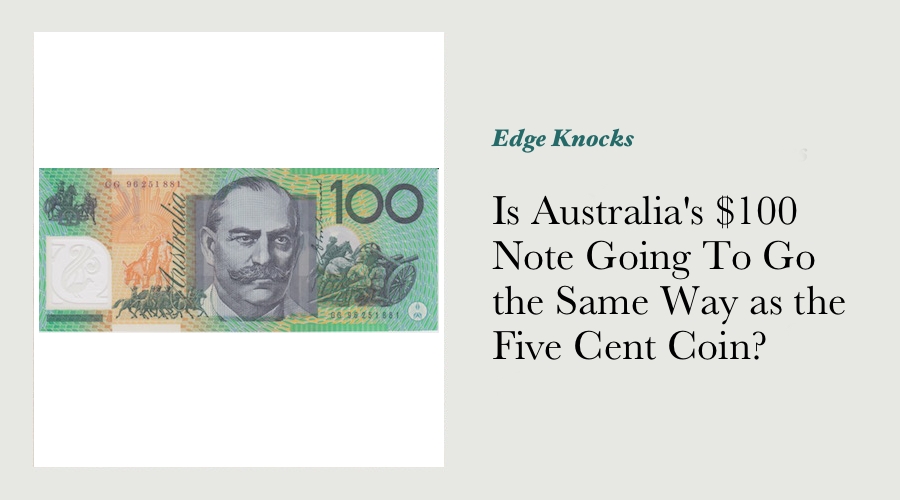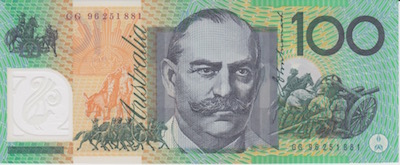Is Australia's $100 Note Going To Go the Same Way as the Five Cent Coin?

Discussion of Australia's circulating currency set mainstream media alight for the third time in 2016 when a UBS analyst in mid November suggested that "Australia should follow India’s lead and scrap its biggest bank notes.” This opinion was shared across a wide range of mainstream media outlets, and stimulated some discussion on a range of topics - the merits of keeping large denominations in circulation, whether it was a criminal act to pay in cash, how much money Australia’s citizens had stashed under their mattresses, and whether criminals would go straight if large denomination banknotes were taken away from them.

Australian $100 Note
Image Source: Sterling & Currency
This opinion was shared hot on the heels of a decision made by the Prime Minister of India to demonetize the two largest denomination notes circulating in that country - the 500 and 1000 rupee notes. PM Modi’s decision on November 8th to remove the legal tender status of both of India’s largest banknotes within hours of his announcement. The reason this was such a shock was because at the moment Modi banned them, the total value of those two bills accounted for roughly 86% of all of the cash in circulation in India.
The Indian demonetisation has been carried out in stages - no longer legal tender from midnight on November 8th, they could be used to pay certain utilities bills for a period of time, and could also be deposited into bank accounts until November 24th, and then at the Central Bank until March.
For many Indians, many of whom live in poverty and or in rural areas, a bank account simply isn’t a luxury they’ve entertained, so whatever meagre wealth they might have saved was effectively wiped out.
The idea of large denomination notes being removed from circulation was raised again in mid December, when Kelly O’Dwyer, the Minister for Revenue and Financial Services, announced that the Commonwealth Government has formed "The Black Economy Taskforce”, with the intent of cracking down on “...people who operate entirely outside the tax system or who are known to tax authorities but deliberately misreport their tax (and superannuation) obligations. The black economy can also include those engaged in organised crime, including those who engage in the production and sale of prohibited goods."
The press conference that announced the Taskforce explained that it would be carefully looking at “... successful measures that have been employed overseas.” A few of the measures referred to were the cash controls recently instituted in France, and the de-monetization of high denomination notes such as the 500 Euro note. The current cash controls in France (in place since September 2016) mean that "people who live in France will not be allowed to make payments of more than 1,000 euros ($1,060) in cash.” Minister O’Dwyer didn’t actually say that the Government was considering removing the $100 note from circulation but she also pointedly said that the Taskforce wouldn’t rule it out.
It seems the reality of even the idea of the $100 note being withdrawn from circulation was enough to get people talking - not only were quotes from the Minister’s press conference and subsequent media interviews parlayed across mainstream media, they were also picked up on social media and some of the more sensational “new” news websites that have come onto the scene in recent years.
The "Black Economy Taskforce” will apparently release an interim report in March 2017, and will present it’s final report in October 2017, so there’s nothing cast in stone yet. That hasn’t stopped libertarians, conspiracy theorists and precious metal bugs the world over as taking this turn of events as firm evidence of “The War On Cash”. Because if you’re not aware, there is apparently a war on cash unfolding around the world as we speak.
Harvard University Economics Professor Kenneth Rogoff actually published a book in September titled "The Curse of Cash”. Rogoff is the former chief economist of the International Monetary Fund, so is definitely someone whose idea on the subject is considered by economists and central bankers the world over. Interestingly, Rogoff not only states that the majority of $100 bills in the US are circulating through the underground economy, but also that “...suppressing cash would make it easier for the Federal Reserve and other central banks to boost economic growth by pushing interest rates into negative territory."
Negative interest rates would seem to be a rather odd concept to the average mortgage owner - it is the strange world where you pay to keep money in the bank and get paid to borrow it. The theory is that negative rates will induce people to save less and spend more, which will revive growth. Savers won't tolerate negative interest rates on their savings as long as cash is an alternative.” Rogoff’s theory is that if you remove cash as an alternative store of value, it then becomes far easier to force the average person to keep the economy ticking over by spending their money rather than saving it.
I don’t think the average Australian would have any idea such measures as strict cash controls and negative interest rates might even be entertained by the Commonwealth Government, however if social media can be set alight by the mooted demise of the five cent coin or the colour of our new $5 note, these ideas will surely get people talking.
In the middle of the extreme views put forward by the “big government” advocatesand the rabid libertarians, are several voices of reason - from within the banking and payments industries no less. Lance Blockley is the MD of bank consultant RFi, which tracks cash usage. He states that Australia hasn't yet had the push from banks, business and government to cut cash. "So I think cash is going to be around for decades yet.” MasterCard Australian country manager Andrew Cartwright has also stated that any move to demonetise Australia’s currency notes won’t happen any time soon: "How long is this journey? I think we are talking decades, not within the next 10 years. I think it is just too big a behavioural shift to happen in a decade.”
I guess we’ll learn whether any of these changes come to pass within the next 12 months, how they affect business generally and the numismatic collectibles market specifically will be interesting to see. Now could well be a great time to put together a set of five cent coins and a set of $100 notes, just in case.
Click here to see our range of rare and collectible Australian 5 cent coins.